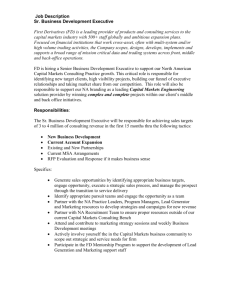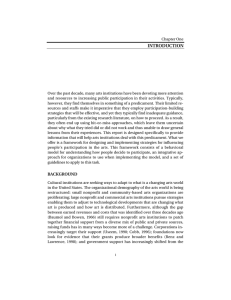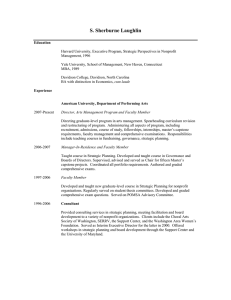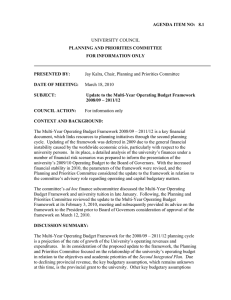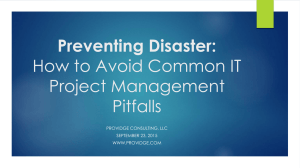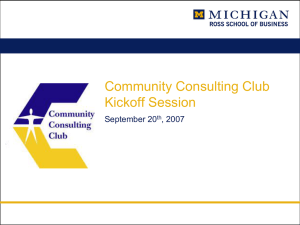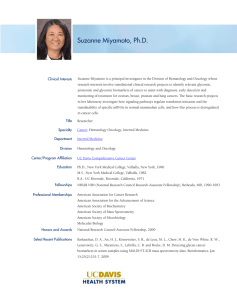Implementation Structure - Nonprofit Learning Point
advertisement
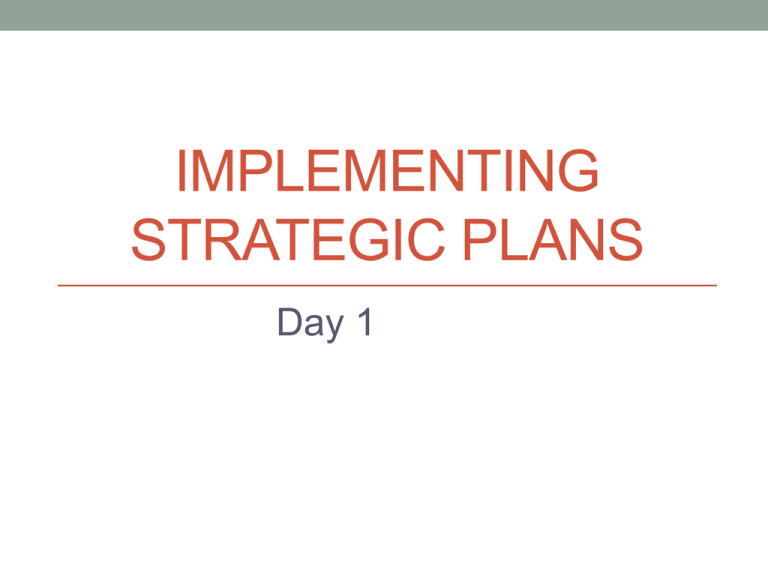
IMPLEMENTING STRATEGIC PLANS Day 1 Welcome – Again! Agenda – Day 1 • Introductions • Case Study • Review of previous classes • Critical Success Factors in Strategy Implementation Agenda – Day 2 • Translating, Measuring, Monitoring, Adjusting • Some tools • In-class exercise • Wrap-up Introductions 1. Your name, organization, your role there 2. Your experience with strategic planning 3. If you have taken other classes in this series, A. What would you like to know more about? B. What is still unclear? Learning Objectives • A clear understanding of the purpose of strategic planning and its importance in organizational success • The process of strategy formulation • The elements of a good strategic plan • The factors that influence the successful implementation of strategy • Some tools that help measure and monitor strategy implementation progress CLASS EXERCISE CASE STUDY Case Questions • What is the purpose and mission of this organization? • Where is it in its organizational lifecycle? • What strategic issues does it currently face? • What steps should the organization take at this time to improve its situation? The Evolution of Strategy • Origins in Military War Campaigns • Adaptation to For-Profit Business • Application in the Nonprofit Sector Dwight D. Eisenhower “In preparing for battle I have always found that plans are useless, but planning is indispensable.” Strategy as a Business Tool • Only about 50 years old • Business Strategy was shaped by three consulting companies and a school • Boston Consulting • Bain Consulting • McKinsey & Company • Harvard Business School Nonprofits and Strategy • Relatively new for nonprofit organizations • Originally funder driven • Takes into consideration the differences between for profit businesses and not-for-profit businesses What is Strategy? “Brilliant strategy is the best route to desirable ends with available means.” Max McKeown, The Strategy Book Perception is strong and sight weak. In strategy it is important to see distant things as if they were close and to take a distanced view of close things.” Miyamoto Musashi Why Strategy? “No business can do everything. Even if it has the money, it will never have enough good people. It has to set priorities. The worst thing to do is a little bit of everything. This makes sure that nothing is being accomplished. It is better to pick the wrong priority than none at all. There is no perfect strategic decision. One always has to pay a price. One always has to balance conflicting objectives, opinions, and priorities. The best strategic decision is only an approximation – and a risk Peter Drucker The Value of Strategic Planning “Alice said, ’would you please tell me which way to go from here?’ The cat said, ‘that depends on where you want to get to.’” Lewis Carroll The Questions that Strategy Answers • Where are we now? • Where do we want to go? • How do we plan to get there? • What will we need to get us there? • How will we know that we are on the right path? • How will we know that we have arrived? 17 Strategic Planning is a Process Strategy Formulation Decision Ready – What to Do Test and Adapt the Strategy Translate the Strategy Innovate and Change Aim – How to Do It Monitor and Learn Plan Operations Action Execute Processes and Initiatives Steer – Doing It 18 What is a Process Process • Something goes in Input • It gets altered • Something different (better) comes out Output Input to the Strategic Planning Process • Environmental Scan (PESTEL) • Organizational Scan • Current Situation • SWOT • Financial Review • Capacity Assessment • Lifecycle Review • Culture • Competitive Situation • Trends • Issues or Imperatives • Barriers or Constraints Alvin Toffler (On thinking strategically) “You’ve got to think about big things while you’re doing small things, so that all the small things go in the right direction.” Elements of A Strategic Plan • Purpose • Mission • Vision • Values • Goals & Objectives • Strategies & Tactics Purpose • Why your organization matters • What would be missing if you did not exist or do what you do • The “so what” behind your mission Vision A vision can focus, direct, motivate, unify, and even excite an organization into superior performance. The job of a strategist is to identify and project a clear vision John Keane (paraphrased) Where there is no vision, the people perish Proverbs 29:18 The Mission Statement • Who you serve • Where you operate • What you do for your clients • What happens as a result of your work Values • The commonly held standards of what is acceptable or unacceptable, important or unimportant, right or wrong, workable or unworkable, etc., in a community or society. • Values represent our guiding principles: our broadest motivations, influencing the attitudes we hold and how we act. Types of Values Goals • A goal is a desired result a person or a system envisions, plans and commits to achieve. • It is the purpose toward which an endeavor is directed. • Example: I want to achieve success in the field of genetic research and do what no one has ever done. Objectives • Something that one's efforts or actions are intended to attain or accomplish • May also be called a target • A tangible, measurable, specific action that supports attainment of the associated goal. • Example: I want to complete this thesis on genetic research by the end of this month. Strategies & Tactics • Strategies are chosen once objectives have been established, because they suggest how objectives can best be achieved. • Strategies are the specific actions needed to achieve the objectives • Tactics are subsets of strategies Example As part of a program to enhance employee awareness of company safety policies, a survey was conducted to assess the proportion of employees who felt adequately informed about company safety policies. • Objective: Increase factory employees' awareness of company safety policies by 20% over a one-year period. • Strategy: Create a controlled, mass media communication tool that is regularly distributed to factory employees, emphasizing safety policies and stressing the importance of safe work practices. • Tactic: Begin a weekly, two-page safety newsletter for factory employees. Output From the Strategic Planning Process • A Multi-year Strategic Plan (sets direction) • A Multi-year Business Plan (determines resource requirements) • An Annual or Operating Plan (guides day-to-day activities) • *A Case Statement (informs stakeholders) Case Study Part II • What are the threats and opportunities? • What else would you want to know? • What would you recommend? Thank You!



